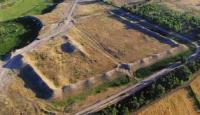You are here
Tuimekent settlement.

Ancient sites of ancient settlement of Kazakhstan.
“An ancient burial site will always hold clues as to who the people were, and to who we are”
Anthony T. Hincks.
Vacation packages in Kazakhstan.
Tuimekent is an ancient city of Turkic tribes full of secrets and mysteries of the past. It is attract ingattention of scientists archaeologists for more than a hundred years, gifting them amazing discoveries. Tuimekent is located on the right bank of the river Talas, Baizak district of the Zhambyl region.
The ancient city existed in the IX - XIII centuries, mostly, representatives of the Turkic tribes lived here. In the period of prosperity a few hundred people lived here at the same time, besides the city was always full of visiting merchants and travelers.
There was a large caravanserai in the center of Tuimekent where travelers from distant countries stayed. Indeed, it was a unique place which has an advantageous geographical position at the crossroads of caravan routes - 25 kilometers from the Great Silk Road, guarded by the eastern part of the Talas valley.
Many local residents escaped here from the onslaught of enemies. The territory of the city represents a relatively small rectangle - 250 to 300 meters. All the sides of it wereem banked and 30 watchtowers were placed around its perimeter.
Tuimekent was a self-sufficient and independent city of that time, despite its comparatively small dimensions, it had its own engineering network providing livelihoods and safety of citizens. During excavations archaeologists discovered a water pipe that extends to a distance of over 30 meters, the pipe was laid under the roadway entrance at a depth of 1.5 - 2 meters. Obviously, it provided the citywith potable water.
Among defensive structures numerous towers of Tuimekent are of particular interest. Archaeologists cut open the outside of one tower and fully convinced that it had played a huge role in protection of the fortress.
The entire perimeter of the city was surrounded by a high wall with a thickness of more than 7 meters and a moat apx. with the width of 15 - 20 meters and depth of up to three meters. That time it was a reliable, well-fortified fortress which could withstand multi-day siege of invaders.
Archaeologists consider its blocks as one of the most valuable finds. They were made of molded clay and alternated with usual mud bricks. Such laying is a kind of seismic zone. Major activities of the townspeople were trade, agriculture, pottery and cattle breeding, hunting and fishing.
Several small medieval settlements with the channels and ditches around them were located in close vicinity of Tuimekent. According to one of the versions of scientists, Tuimekent was founded by Khan Kokshe, he laid the town and called it by the name of his daughter Tuime.
After her father's death it wasshe who successfully ruled the city and contributed a lot to its development and prosperity. The site Tuimekent was firstly discovered and studied by the researcher Kalem in 1890.
Since then archaeological excavations were repeatedly conducted on the site by both Soviet scientists and Kazakhstan archeologists. Today, according to many scholars the settlement Tuimekent is widely regarded as one of the most important cultural heritages of Kazakhstan, it is the evidence of the fact that our ancestors had built cities and palaces, and led a settled life as well.
Authority:
Eleuov. M, Kaliev S, Esenov S, Beisebaev A. Institut of archeology it. A. Margulan. http://culturemap.kz







